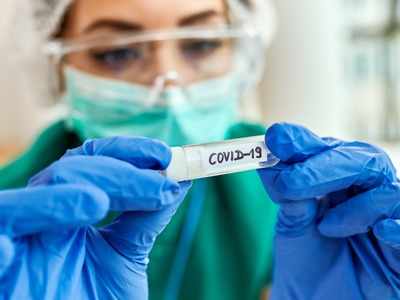- News
- lifestyle
- health-fitness
- health-news
- Coronavirus: What is CT-count in a COVID-19 test? What does it tell you about your infection?
Trending
This story is from April 25, 2021
Coronavirus: What is CT-count in a COVID-19 test? What does it tell you about your infection?
COVID RT-PCR tests and scans mention a CT value that helps determine the positivity rate. But what does it tell you about your infection?

As the pandemic's second wave continues to rage on in full force, the emphasis remains on widespread testing.
Now, the usual method for detection of the novel coronavirus, and its many mutant strains is by conducting an RT-PCR test. The positivity criteria for the samples is determined by the number of 'cycles' or cycle threshold needed to detect the virus presence in the sample.This is otherwise known as the CT value, which has been referred to often in COVID tests and scans, and with the rise in cases, back in the news.
What does CT value mean? How does it help determine transmission and infection rates?
Scientifically, a CT value signals the number of cycles for a sample to go through to amplify and bring up the viral DNA to a traceable level under given settings.
The DNA is then analyzed and measured under clinical settings and using specific dyes, which then helps collect and estimate the CT value in a given sample.
As per current guidelines issued by the ICMR, the positivity rate is measured of how soon after an RT-PCR test the viral variant is detected in the sample.
What can CT value tell you about your infection?
The CT count also helps determine the viral load present in your body.
To simplify, lower the CT value, the higher is the viral load and higher the CT value, lesser is the viral load said to be in the body.
According to medical guidelines referred globally, a CT value below the number 35 means a person is COVID positive, whereas a CT value of 35 and above qualifies as a negative report.
The ICMR states that the globally accepted cut-off for CT value for Covid-19 ranges from 35-40 depending upon the instructions laid down by individual manufacturers.
CT count can also be referred via a chest scan for COVID patients who may get a negative RT-PCR/ RAT report (i.e., insufficient viral load is detected in the nose and throat samples) but sizeable viral load is present in the lungs and chest cavity. However, it should be remembered that the CT value in a chest scan signifies a different value. In a chest scan, higher the CT value, higher is the severity of the infection. This is also referred to as the CT score and different from the CT value found via PCR tests.
Here's why this is important
It's crucial to remember that CT value shares an inverse relationship with the viral load. Now, the measure of CT value could also have an impact on how the disease or infection severity is treated by the patient. Earlier during the pandemic's rise, there were rumours that made people think that lower the CT count signifies lesser viral load, and hence, signified a low-threshold or mild bout of infection. That's not completely true.
With a low cycle run, one can still get a positive result if the value load is high. If you lower down the CT value, that will pose a serious problem because the person is still infected, he would have a low viral load - the person would be negative. Although he may have an illness, he may not seek treatment. False-negative results could be able to transmit the infection to the family and the society. In a similar manner, a person can have a high CT value but still have a very significant level of covid19 infection, a patient can have a low CT value, but the patient may be asymptomatic. Many factors like the collection of the sample, what day it was collected, where was it stored, what were the reagents used.
Now, the usual method for detection of the novel coronavirus, and its many mutant strains is by conducting an RT-PCR test. The positivity criteria for the samples is determined by the number of 'cycles' or cycle threshold needed to detect the virus presence in the sample.This is otherwise known as the CT value, which has been referred to often in COVID tests and scans, and with the rise in cases, back in the news.
What does CT value mean? How does it help determine transmission and infection rates?
Scientifically, a CT value signals the number of cycles for a sample to go through to amplify and bring up the viral DNA to a traceable level under given settings.
In diagnostic terms, a COVID report always mentions a CT count, which gives the suspected patient an idea as to how many cycles were needed to detect the DNA of the SARS-COV-2 virus. The count is determined when the sample is collected from the patient, extracting the RNA from it, which is then treated with a reverse transcriptase enzyme. A part of the DNA is also extracted, which is then later amplified using a polymerase chain reaction to produce copies.
The DNA is then analyzed and measured under clinical settings and using specific dyes, which then helps collect and estimate the CT value in a given sample.
As per current guidelines issued by the ICMR, the positivity rate is measured of how soon after an RT-PCR test the viral variant is detected in the sample.
What can CT value tell you about your infection?
The CT count also helps determine the viral load present in your body.
To simplify, lower the CT value, the higher is the viral load and higher the CT value, lesser is the viral load said to be in the body.
According to medical guidelines referred globally, a CT value below the number 35 means a person is COVID positive, whereas a CT value of 35 and above qualifies as a negative report.
The ICMR states that the globally accepted cut-off for CT value for Covid-19 ranges from 35-40 depending upon the instructions laid down by individual manufacturers.
CT count can also be referred via a chest scan for COVID patients who may get a negative RT-PCR/ RAT report (i.e., insufficient viral load is detected in the nose and throat samples) but sizeable viral load is present in the lungs and chest cavity. However, it should be remembered that the CT value in a chest scan signifies a different value. In a chest scan, higher the CT value, higher is the severity of the infection. This is also referred to as the CT score and different from the CT value found via PCR tests.
Here's why this is important
It's crucial to remember that CT value shares an inverse relationship with the viral load. Now, the measure of CT value could also have an impact on how the disease or infection severity is treated by the patient. Earlier during the pandemic's rise, there were rumours that made people think that lower the CT count signifies lesser viral load, and hence, signified a low-threshold or mild bout of infection. That's not completely true.
With a low cycle run, one can still get a positive result if the value load is high. If you lower down the CT value, that will pose a serious problem because the person is still infected, he would have a low viral load - the person would be negative. Although he may have an illness, he may not seek treatment. False-negative results could be able to transmit the infection to the family and the society. In a similar manner, a person can have a high CT value but still have a very significant level of covid19 infection, a patient can have a low CT value, but the patient may be asymptomatic. Many factors like the collection of the sample, what day it was collected, where was it stored, what were the reagents used.
End of Article
FOLLOW US ON SOCIAL MEDIA









